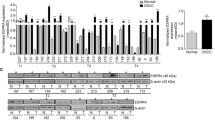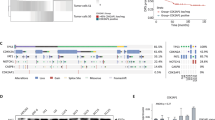Abstract
Background: We previously reported differential expression of the growth suppressor, deleted in oral cancer-1 (DOC-1), in microsatellite-unstable (MSI+) versus microsatellite-stable colorectal cancer (CRC) cell lines. MSI+ CRC cell lines demonstrated decreased DOC-1 expression and decreased apoptosis. Transfection of wild-type DOC-1 into an MSI+ cell line (SW48) resulted in increased apoptosis. We undertook our current experiment to identify specific elements modulated by DOC-1 expression that result in increased apoptosis.
Methods: SW48 is an MSI+ CRC cell line that does not constitutively express DOC-1. SW48 was suspended in culture medium and incubated to 60% confluence. Half the plates were transfected with cytomegalovirus (CMV)-DOC-1. At 30 hours, RNA and protein were isolated with Trizol. Complementary DNA microarray was performed to compare SW48CMV-DOC-1 with SW48, which lacks DOC-1. Signal intensity was analyzed by GenePix Pro 3.0 software. Expression ratios ≤.67 and ≥1.5 were considered significant. Poor-quality spots were flagged and excluded from analysis. Real-time polymerase chain reaction was performed to determine DOC-1 levels in both cell lines.
Results: Successful transfection of DOC-1 was confirmed by real-time polymerase chain reaction and by Western blot. Microarray revealed significant differential expression of DOC-1, as expected. Increased DOC-1 expression in SW48CMV-DOC-1 was associated with significantly increased expression of proapoptosis components of the caspase cascade (CASP7, CASP9) and bcl2/bax pathway (BNIP3, BNIP3L, BID).
Conclusions: DOC-1 expression promotes apoptosis by upregulation of specific elements of the caspase cascade and bcl2/bax pathways. DOC-1 therefore deserves further study as a candidate for the therapeutic modulation of apoptosis in MSI+ CRC.
Similar content being viewed by others
References
Boland CR. Genetic pathways to colorectal cancer. Hosp Pract 1997;32:87–96.
Rodriguez-Bigas MA, Boland C, Hamilton SR, et al. A National Cancer Institute Workshop on Hereditary Nonpolyposis Colorectal Cancer Syndrome: meeting highlights and Bethesda guidelines. J Natl Cancer Inst 1997;89:1758–1762.
Lynch HT, de la Chapelle A. Genetic susceptibility to non-polyposis colorectal cancer. J Med Genet 1999;36:801–818.
Boland CR, Thibodeau SN, Hamilton SR, et al. A National Cancer Institute Workshop on Microsatellite Instability for cancer detection and familial predisposition: development of international criteria for the determination of microsatellite instability in colorectal cancer. Cancer Res 1998;58:5248–5257.
Rampino N, Yamamoto H, Ionov Y, et al. Somatic frameshift mutations in the BAX gene in colon cancers of the microsatellite mutator phenotype. Science 1997;275:967–969.
Kinzler KW, Vogelstein B. Lessons from hereditary colorectal cancer. Cell 1996;87:159–170.
Markowitz S. TGF-beta receptors and DNA repair genes, coupled targets in a pathway of human colon carcinogenesis. Biochim Biophys Acta 2000;1470:M13–20.
Yuan ZQ, Sotsky Kent T, Weber TK. Differential expression of DOC-1 in microsatellite-unstable human colorectal cancer. Oncogene 2003;22:6304–6310.
Todd R, McBride J, Tsuji T, et al. Deleted in oral cancer-1 (doc-1), a novel oral tumor suppressor gene. FASEB J 1995;9:1362–1370.
Tsuji T, Duh F, Latif F, et al. Cloning, mapping, expression, function, and mutation analyses of the human ortholog of the hamster putative tumor suppressor gene Doc-1. J Biol Chem 1998;273:6704–6709.
Matsuo K, Shintani S, Tsuji T, et al. p12(DOC-1), a growth suppressor, associates with DNA polymerase alpha/primase. FASEB J 2000;14:1318–1324.
Shintani S, Ohyama H, Zhang X, et al. p12(DOC-1) is a novel cyclin-dependent kinase 2-associated protein. Mol Cell Biol 2000;20:6300–6307.
Hu M, Wong DT. p12DOC-1 mediates TGF-beta antiproliferation by negatively regulating CDK2 phosphorylation of RB (abstract). Proc AACR 2002;43:226.
Shintani S, Mihara M, Terakado N, et al. Reduction of p12DOC-1 expression is a negative prognostic indicator in patients with surgically resected oral squamous cell carcinoma. Clin Cancer Res 2001;7:2776–2782.
Morgan DO. Principles of CDK regulation. Nature 1995;374:131–134.
Cwikla SJ, Tsuji T, McBride J, Wong DT, Todd R. DOC-1-mediated apoptosis in malignant hamster oral keratinocytes. J Oral Maxillofac Surg 2000;58:406–414.
Kohno Y, Patel V, Kim Y, et al. Apoptosis, proliferation and p12(doc-1) profiles in normal, dysplastic and malignant squamous epithelium of the Syrian hamster cheek pouch model. Oral Oncol 2002;38:274–280.
Peltomaki P, Vasen HF. Mutations predisposing to hereditary nonpolyposis colorectal cancer: database and results of a collaborative study. The International Collaborative Group on Hereditary Nonpolyposis Colorectal Cancer. Gastroenterology 1997;113:1146–1158.
Gryfe R, Kim H, Hsieh ET, et al. Tumor microsatellite instability and clinical outcome in young patients with colorectal cancer. N Engl J Med 2000;342:69–77.
Barnetson RA, Symons P, Robinson BG, Schnitzler M. Genetic analysis of multiple sporadic colon carcinomas from a single patient. Int J Colorectal Dis 2000;15:83–86.
Martin L, Assem M, Piara F. Are there several types of colorectal carcinomas? Correlations with genetic data. Eur J Cancer Prev 1999;8(Suppl 1):S13–20.
Loeb LA. A mutator phenotype in cancer. Cancer Res 1999;61:3230–3239.
Sankila R, Aaltonen LA, Jarvinen HJ, Mecklin JP. Better survival rates in patients with MLH1-associated hereditary colorectal cancer. Gastroenterology 1996;110:682–687.
Kruschewski M, Noske A, Haier J, Runkel N, Anagnostopoulos Y, Buhr HJ. Is reduced expression of mismatch repair genes MLH1 and MSH2 in patients with sporadic colorectal cancer related to their prognosis?. Clin Exp Metastasis 2002;19:71–77.
Shintani S, Mihara M, Nakahara Y, et al. Expression of cell cycle control proteins in normal epithelium, premalignant and malignant lesions of oral cavity. Oral Oncol 2002;38:235–243.
Author information
Authors and Affiliations
Corresponding author
Rights and permissions
About this article
Cite this article
Kent, T.S., Yuan, Z., Miller, A. et al. Deleted in Oral Cancer-1 Expression Upregulates Proapoptosis Elements in Microsatellite-Unstable Human Colorectal Cancer. Ann Surg Oncol 11, 192–196 (2004). https://doi.org/10.1245/ASO.2004.03.056
Received:
Accepted:
Issue Date:
DOI: https://doi.org/10.1245/ASO.2004.03.056




